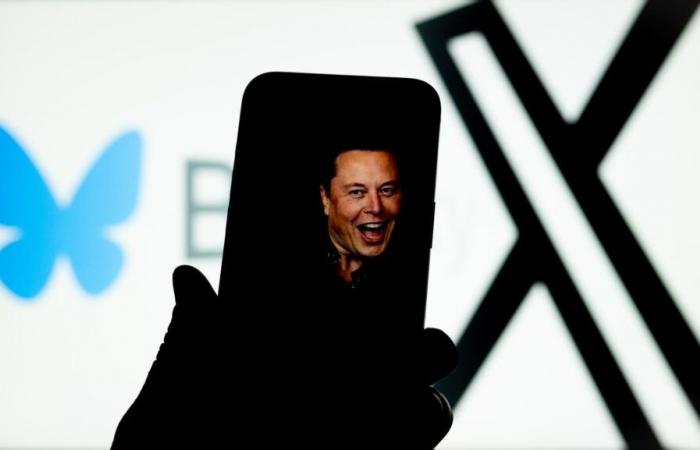X (Twitter) users are slowly migrating to Bluesky. (Photo by Jaap Arriens/NurPhoto via Getty Images)
NurPhoto via Getty Images
“X,” the site formerly known as Twitter, has been bleeding users (and advertisers) since Elon Musk took over the site and made many unpopular changes.
The slow migration has exploded into an exodus to Bluesky, a competing microblogging platform that now boasts 20 million users, with a large number of celebrities and news publishers leading the way.
What Is Bluesky?
Bluesky is, essentially, a Twitter clone founded by former Twitter CEO Jack Dorsey, who has since cut ties with the company; Bluesky is currently run by software engineer Jay Graber.
As a text-based social media site, Bluesky offers an almost identical experience to Twitter, but with a few interesting tweaks, such as giving users far greater control over what they see on their timeline, with customized feeds.
Bluesky is also federated, meaning users can operate their own servers rather than relying on the site’s official servers; users can switch servers at any time, without changing their username, timeline or friend lists.
While Musk’s mercurial leadership has alienated many Twitter users, Bluesky had a slow start, remaining invite-only until February, but has recently begun to surge in popularity, as more users flee X.
Several Hollywood celebrities have since moved to Bluesky, such as: Stephen King, Jamie Lee Curtis, Lilly Wachowski, Guillermo del Toro, Ben Stiller, Lizzo, Mara Wilson, George Takei, Quinta Brunson, Mark Hamill and Weird Al Yankovic.
The opportunity to interact with real celebrities once made Twitter stand out from the competition, but it’s unclear if Hollywood’s finest still wield the same clout today—the internet has changed a lot in the last decade, and so has the public perception of celebrities.
Influencers from outside the entertainment industry have proved to be talented, intuitive content creators, able to attract huge, dedicated followings without the help of Hollywood.
Indeed, some X users have joked that the site will only improve as the celebrities leave.
At the moment, Bluesky is ad-free (don’t expect this to last), and isn’t infested with bigotry and bots the way X currently is.
However, old habits die hard, and many chronically online X posters have been reluctant to leave the platform, with some simply dropping social media altogether.
Why Are X (Twitter) Users Fleeing The Site?
X has undergone hugely consequential changes under the ownership of Elon Musk; one of the most controversial has been the watering down of the block function, as blocking a user on X no longer stops them from viewing your posts, only from interacting.
Critics have argued that the change will lead to harassment, and embolden stalkers, but blocking is just the latest in a long line of unpopular changes.
Twitter’s blue checkmarks were once a stamp of authenticity, but were changed from a verification tool to a paid subscription, with paid subscribers now algorithmically boosted, their replies automatically placed in the top row of comments, regardless of how inane or dull they may be.
Content moderation on X has all but disappeared, and bigotry has become exceedingly common; the culture on the site is now closer to 4chan than classic Twitter.
Bots of all kinds now flood the site, posting content, clogging the comments with porn and meaningless ChatGPT drivel.
Is X (Twitter) Really Dying?
Yes, and no. Despite X’s ever-increasing hostility to users, the site once known as Twitter is still a cultural hotbed of discourse.
The terrible toxicity seems integral to the site’s addictiveness, each swipe of the app like inhaling a strong cigarette, or gulping a shot of absinthe; dedicated users can’t seem to stop logging in.
Even before Musk’s takeover, Twitter was a pretty toxic place, a deranged arena of sharp tongues and misinterpreted sentences that regularly sparked absurd conversations and controversies.
It was always kind of a mess, and many seem to be thriving in X’s death spiral.
Even watching Musk fiddle with the site’s engine in real-time can be entertaining, like watching a train slowly detach from its tracks, sure to crash, to crumple into a heap of molten metal at any moment.
The peak of Twitter isn’t an easy thing to recreate; the site has been fermenting in memes for years, and it was always given a disproportionate amount of attention from journalists and content creators.
X’s cultural power is diminishing, but it hasn’t gone away entirely; perhaps it never will. There are still gemstones hiding in the dirt, for those willing to get their hands dirty.
Bluesky still has a long way to go before it can build up the unique culture that once made Twitter such a powerhouse, and there’s no guarantee that a microblogging site will ever have that kind of influence again.
Plus, Bluesky has plenty of competition—Threads and Mastodon are Twitter clones too, with their own benefits and drawbacks, while YouTube and TikTok are leading the pack, defining the current internet era as video-based, rather than text-based.
For the time being, Bluesky is a fairly peaceful oasis, away from the slow-motion car crash that is X; we’ll see if the site can be the next Twitter, or carve out a new identity entirely.
MORE FROM FORBES
ForbesCoca Cola’s AI-Generated Ad Controversy, ExplainedBy Dani Di PlacidoForbes‘Piglet’s Big Game’ Sells Out After Creepy Gameplay Footage Goes ViralBy Dani Di PlacidoForbesTikTok’s ‘Hear Me Out’ Cake Trend, ExplainedBy Dani Di PlacidoForbesHow YouTube Became A Horror PlaygroundBy Dani Di Placido






